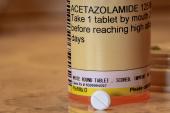Early, Intense GDMT Improves Decongestion in Acute HF: STRONG-HF
Quickly uptitrating neurohormonal blockade made a difference—yet to be seen is if SGLT2 inhibitors add even more benefit.

Rapid uptitration of neurohormonal blockade through guideline-directed medical therapy (GDMT) boosts decongestion in patients admitted for acute heart failure (HF), according to a post hoc analysis of the STRONG-HF trial. That benefit, in turn, appears to translate into better clinical outcomes.
Successful decongestion by 90 days was significantly more common in the patients who received high-intensity versus usual care (75% vs 68%; P = 0.0001), with several other measures of decongestion supporting that result, researchers led by Jan Biegus, MD, PhD (Wroclaw Medical University, Poland), report.
That difference held even though the mean daily dose of loop diuretics was lower in the high-intensity arm at the 90-day time point, a finding that supports the concept that neurohormonal blockade is facilitating decongestion through a mechanism beyond a purely diuretic effect, Biegus told TCTMD.
“We think and we hope that by using neurohormonal blockade and uptitrating it quite aggressively, we can stop the process of congestion development at the very beginning,” he said. This could have an impact on clinical outcomes, as successful decongestion was associated with a lower risk of HF readmission or all-cause death at 180 days in the trial.
The findings, published in the July 23, 2024, issue of the Journal of the American College of Cardiology, “can impact our everyday clinical life,” Biegus said. Loop diuretics remain the first choice for a patient with acute HF who presents with signs and symptoms of congestion, but this analysis suggests GDMT may have a decongestive role to play as well, he indicated.
“When the patient has no overt fluid overload but still some residual congestion, probably it’s much better to uptitrate GDMT than to keep on pushing on diuretics because diuretics do not change the trajectory of the disease—neurohormonal blockade does,” Biegus said.
Decongestion in STRONG-HF
Congestion is a major driver of worsening HF and a leading cause of acute HF hospitalizations, Biegus said, noting that the condition is treated not only to prevent admissions but also to maintain patients’ quality of life.
The STRONG-HF trial presented an opportunity to explore a possible decongestive role for neurohormonal blockade given on top of standard loop diuretics as part of GDMT. The trial randomized patients with acute heart failure who were hemodynamically stable to high-intensity care consisting of rapid uptitration of beta-blockers, renin-angiotensin-aldosterone system (RAAS) inhibitors, and mineralocorticoid receptor antagonists (MRAs) or to usual care, with the main results showing that aggressive treatment reduced the rate of HF readmission or all-cause death at 180 days.
When the patient has no overt fluid overload but still some residual congestion, probably it’s much better to uptitrate GDMT than to keep on pushing on diuretics. Jan Biegus
This post hoc analysis delves deeper into the effects of the intervention on decongestion. The main endpoint of interest was successful decongestion, defined as the absence of peripheral edema and pulmonary rales accompanied by a jugular venous pressure of less than 6 cm (congestion score of 0).
Just prior to randomization, the proportion of patients with successful decongestion was similar in the high-intensity and usual-care arms (48% vs 46%; P = 0.52), although this rate was significantly greater in the high-intensity arm at 90 days. Each component of the congestion score favored early, more aggressive use of GDMT.
Other indicators of decongestion also were improved by high-intensity care by 90 days, including body weight reduction, levels of NT-proBNP and bilirubin, and orthopnea severity. Those improvements were achieved with a lower mean dose of loop diuretics at 90 days (53 vs 59 mg; P = 0.0376); there was no longer a significant difference at 180 days.
Successful decongestion at 90 days was more likely after high-intensity versus usual care among both patients who were already decongested before randomization and those who remained congested at baseline.
In terms of clinical outcomes, successful decongestion was associated with a lower risk of HF readmission or all-cause death at 180 days (HR 0.40; 95% CI 0.27-0.59), as well as each of the components of that composite endpoint.
“This is the first evidence that in patients with acute HF, an intensive and comprehensive uptitration of neurohormonal blockade . . . in the early postdischarge phase facilitates effective decongestion, which may translate into better outcomes,” Biegus et al write.
Some Caveats
Commenting for TCTMD, Navin Kapur, MD (Tufts Medical Center, Boston, MA), called STRONG-HF an important study that delivers the message that early and aggressive uptitration of GDMT for heart failure is critical for the successful care of patients.
In focusing on decongestion, this analysis of the trial highlights “quite a large topic” that is still debated, he said, citing open questions about the importance of getting patients decongested, how adequate diuresis is defined, how successful decongestion should be defined and measured, and others.
There are some issues to consider when interpreting the results, Kapur added. Patients had to be hemodynamically stable before randomization, resulting in the inclusion of a less-sick population of patients with acute HF than would be seen in everyday practice, he said. Indeed, he added, the low rates of readmission observed in STRONG-HF conflict with his clinical experience, which involves many patients returning to the hospital with congestion despite being on optimal GDMT.
In addition, Kapur pointed out, STRONG-HF was done in an era when there weren’t high levels of use of angiotensin receptor-neprilysin inhibitors (ARNIs) or sodium-glucose cotransporter 2 (SGLT2) inhibitors, which are now essential components of GDMT for heart failure and may influence both efficacy and tolerability.
Overall, though, this analysis “supports the continued role of GDMT and trying to get to optimal doses of all four pillars of GDMT as best as possible in your clinical population,” Kapur said.
In an accompanying editorial, Biykem Bozkurt, MD, PhD (Michael E. DeBakey VA Medical Center and Baylor College of Medicine, Houston, TX), and Ajith Nair, MD (Baylor College of Medicine), highlight how challenging that may be, noting that even within STRONG-HF, not all patients could tolerate full doses of the medications.
“Some patients may require slower uptitration in doses due to hypotension, bradycardia, hyperkalemia, renal dysfunction, and other factors. However, these patients often experience worse outcomes and should be considered for reattempts in the optimization of GDMT and additional HF therapies,” they write. “Overall, the results of the STRONG-HF analysis provide compelling evidence for a shift toward more proactive and intensive use of neurohormonal blockade. Early and intensive uptitration of GDMT can lead to sustainable clinical benefits and improved outcomes.”
Todd Neale is the Associate News Editor for TCTMD and a Senior Medical Journalist. He got his start in journalism at …
Read Full BioSources
Biegus J, Mebazaa A, Davison B, et al. Effects of rapid uptitration of neurohormonal blockade on effective, sustainable decongestion and outcomes in STRONG-HF. J Am Coll Cardiol. 2024;84(4):323-336.
Bozkurt B, Nair A. Early uptitration of GDMT is associated with more successful decongestion and better outcomes. J Am Coll Cardiol. 2024;84(4):337-339.
Disclosures
- The study was funded through a grant provided to Heart Initiative by Roche Diagnostics International.
- Biegus and Kapur report no relevant conflicts of interest.
- Bozkurt reports having been a consultant or having received an advisory committee role for Abiomed, AstraZeneca, Amgen, Bayer, Sanofi, Vifor, Merck, Roche, Boehringer Ingelheim, Zoll/Respicardia, Johnson & Johnson, and Hanger Institute; and having served on clinical event committees of Abbott Vascular and data safety monitoring committees of Novo Nordisk, Regeneron, and LivaNova.
- Nair reports having been a consultant or having received an advisory committee role for Gossamer Bio, Johnson & Johnson, Impulse Dynamics, and Abbott.





Comments